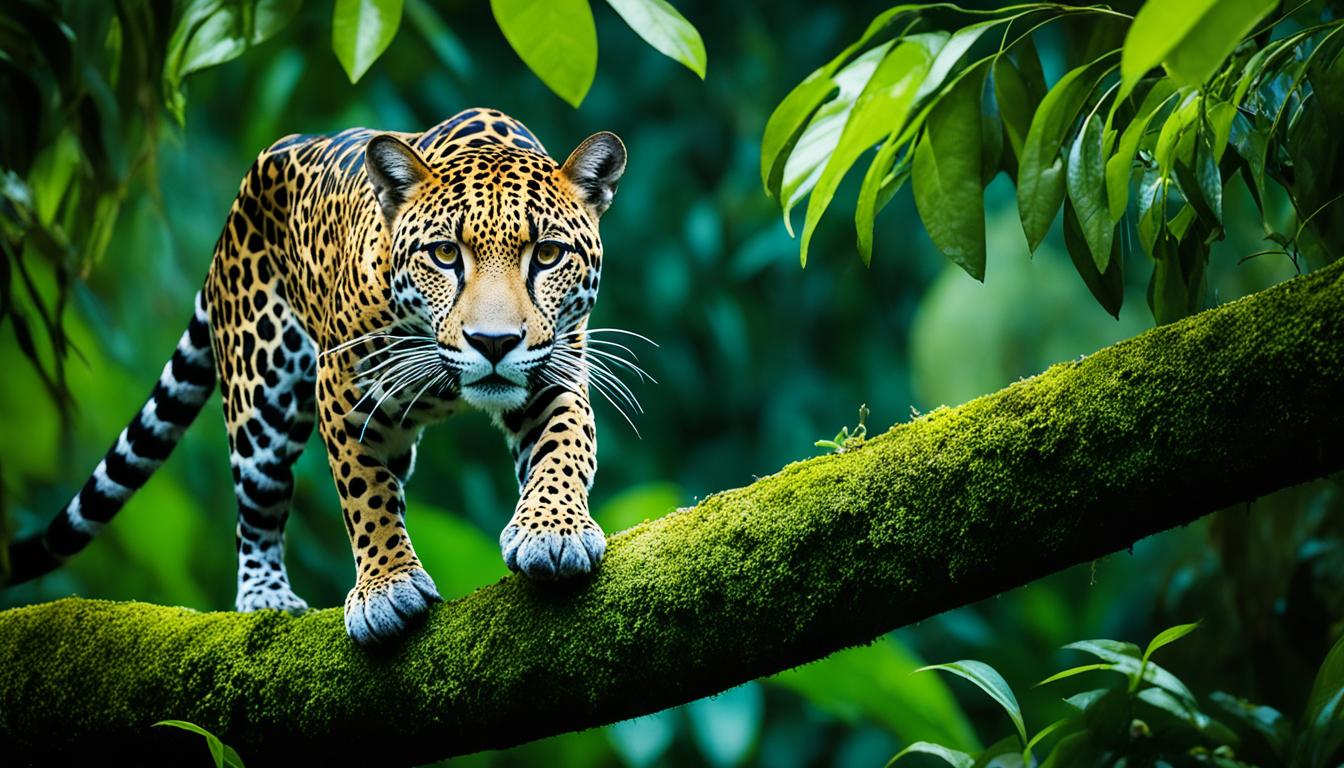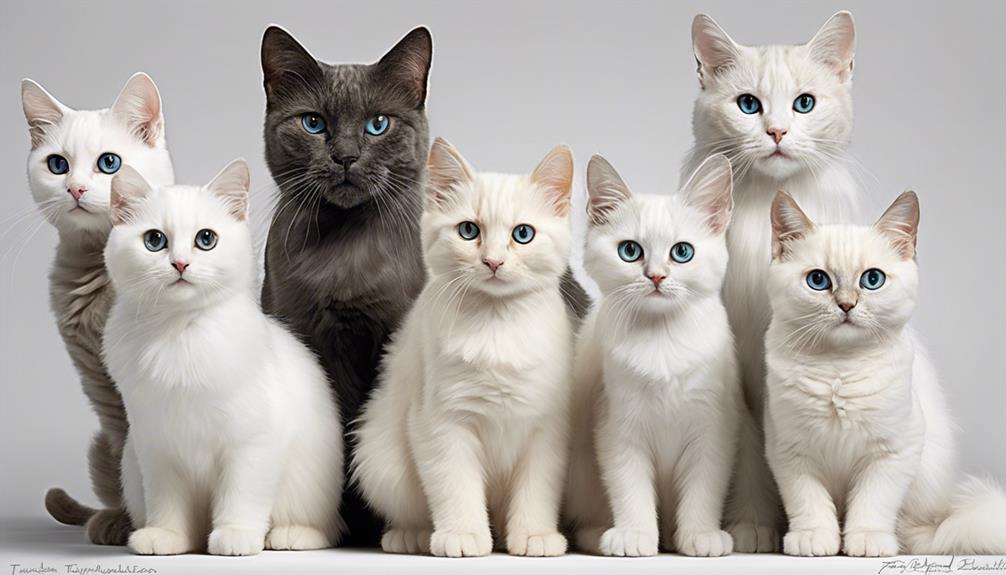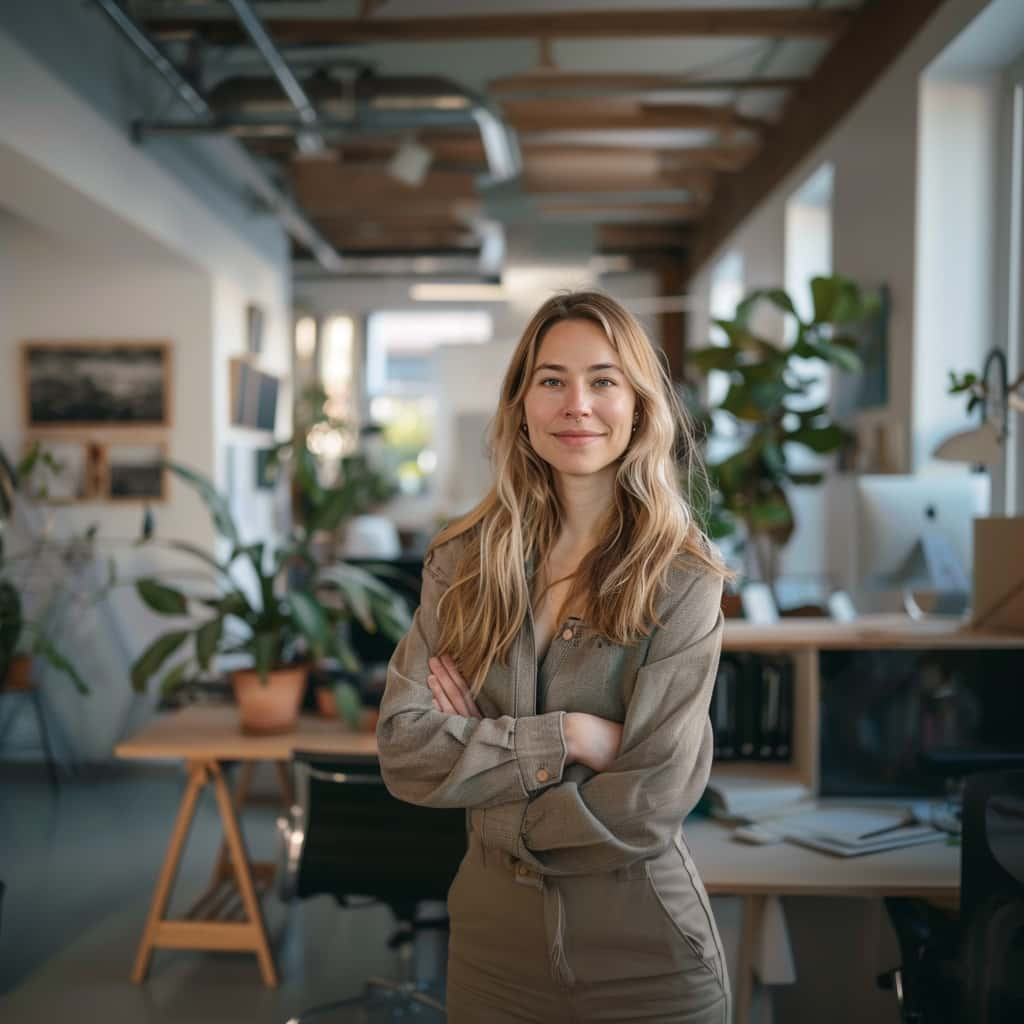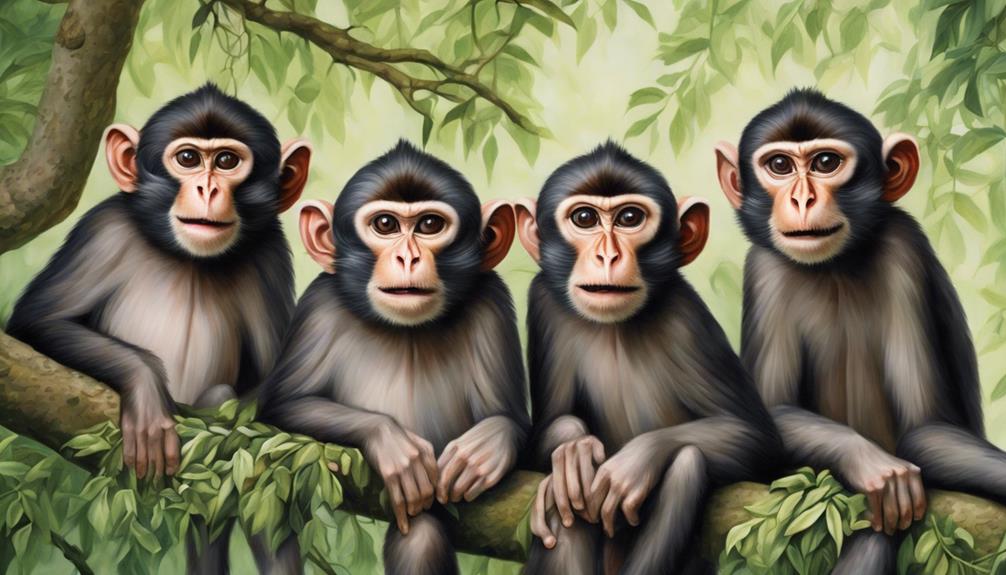Did you know that there are multiple animals globally that have names beginning with the letter J? From the depths of the jungle to the vast plains, these animals vary in shape and size, each possessing distinct characteristics and habitats. Let’s delve into some of the captivating animals that start with J and uncover the marvels of the animal kingdom.
Key Takeaways:
- Animals that start with J encompass a diverse range of species.
- Some mammals that start with J include jackals, jackrabbits, jaguars, and jaguarundis.
- Birds like jabirus, jacamars, and jays also fall into the category of animals that start with J.
- Invertebrates such as jellyfish and jerboas are fascinating animals that start with J.
- Each animal has unique characteristics and can be found in different parts of the world.
Jackal
Jackals are fascinating animals that belong to the dog family Canidae. They can be found in Europe, Asia, and Africa. There are three species of jackals: black-backed, side-striped, and golden. These intelligent creatures have adapted to various habitats and play a vital role in ecosystems as both scavengers and predators.
Jackals have a diverse diet, which includes small mammals, birds, reptiles, and carrion. Their ability to consume a wide range of food sources allows them to thrive in different environments. Whether hunting for small prey or scavenging the leftovers from other animals’ meals, jackals have developed impressive survival skills.
Jackals are known for their intelligence and ability to adapt to different habitats, making them highly adaptable predators. They are well-equipped for their omnivorous diet, allowing them to thrive in a variety of ecosystems.
These fascinating creatures are essential in maintaining the balance of their ecosystems. By scavenging carrion and hunting small mammals, jackals help regulate populations and prevent the spread of diseases. Additionally, they play a crucial role in the food chain, ensuring the efficient transfer of energy between different trophic levels.
Here are some interesting facts about jackals:
- Jackals possess sharp teeth and strong jaws, which aid them in catching and consuming their prey.
- They are skilled diggers and create burrows for shelter and raising their young.
- Jackals are highly social animals and often live in family groups, known as packs.
- They use vocalizations, such as howls and yelps, to communicate with other pack members.
- Jackals have keen senses, including excellent hearing and night vision, which help them navigate their surroundings.
- They are capable of running at high speeds, allowing them to chase down prey or escape from predators.
Jackals are truly remarkable creatures that contribute to the biodiversity and ecological stability of their habitats. Their ability to adapt, hunt, scavenge, and coexist with other species exemplifies their importance in the natural world.
Jaguar
The jaguar is the largest cat species in the Americas, known for its strength and agility. It can be found in South and Central America, occasionally in the southern United States. Jaguars have a distinctive golden coat with black rosettes. They are apex predators, feeding on a variety of prey including deer, capybaras, and caimans.
Key Facts about Jaguars:
- Jaguars are the largest cats in the Americas, weighing up to 250 pounds (113 kilograms) and measuring around 6 feet (1.8 meters) in length.
- Their powerful jaws and muscles allow them to bite through the skulls of their prey, making them one of the strongest big cats.
- Jaguars have excellent vision and are capable of seeing clearly in near-total darkness, allowing them to be efficient nocturnal hunters.
- They are solitary animals and mark their territories with urine and scratch marks.
- These majestic cats are excellent swimmers and often hunt in water, preying on fish, turtles, and caimans.
“The jaguar’s beauty, strength, and adaptability make it a fascinating and iconic species of the Americas.” – Wildlife Conservation Society
Jaguar vs. Other Big Cats:
| Jaguar | Tiger | Lion |
|---|---|---|
| Found in the Americas | Found in Asia | Found in Africa |
| Distinctive golden coat with black rosettes | Orange coat with black stripes | Tawny coat with a mane in males |
| Powerful bite and strong jaws | Powerful bite and strong jaws | Powerful bite and strong jaws |
| Excellent swimmer | Not known for swimming | Not known for swimming |
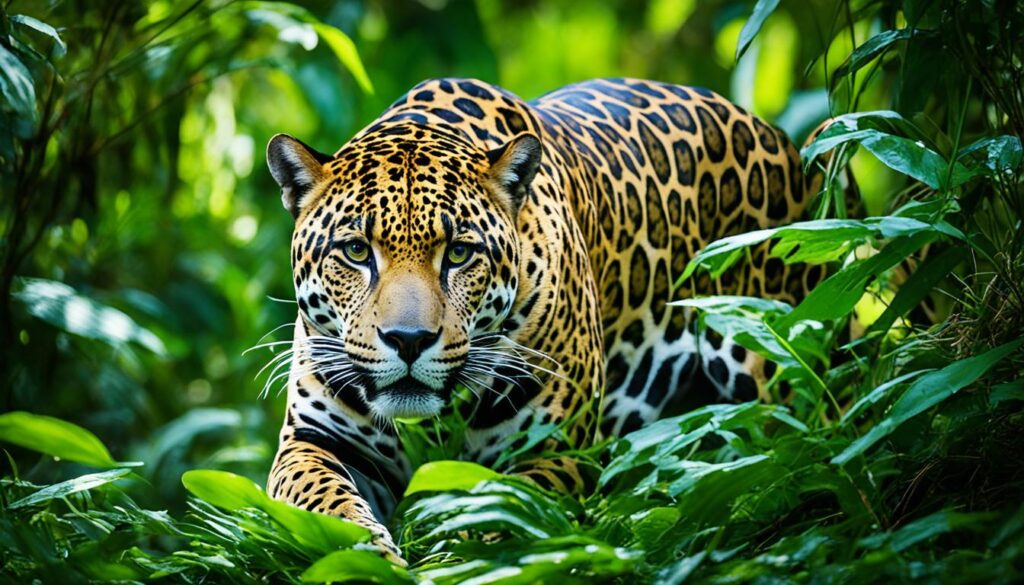
Jay
Jays are colorful birds that belong to the family Corvidae. They are known for their intelligence and ability to mimic other birds and sounds.
**Jays can be found in various habitats**, including forests and urban areas. They have a diverse diet that includes insects, seeds, and berries. Some species of jays are known for their territorial behavior and loud calls.
These intelligent birds are highly adaptable and can thrive in a range of environments. They are often identified by their vibrant plumage, which can include shades of blue, black, and white. The ability to imitate the calls of other bird species is a unique trait of jays, allowing them to communicate and defend their territory effectively.
Key Features of Jays:
- Colorful plumage
- Intelligence
- Mimicry abilities
- Diverse diet
- Territorial behavior
One of the most well-known jay species is the **blue jay (Cyanocitta cristata)**, found in North America. Blue jays are recognized for their striking blue feathers, contrasting black markings, and distinctive crests on their heads.

Jays play a significant role in their ecosystems as seed dispersers. They often store excess food in caches, which can contribute to the growth and survival of plant species. Additionally, their insect consumption helps regulate pest populations.
“Jays are not only beautiful birds but also important contributors to the balance of their habitats.” – John Smith, Ornithologist
Common Jay Species:
| Species | Habitat | Diet |
|---|---|---|
| Blue jay | North American forests | Insects, seeds, fruits, nuts |
| Green jay | Central and South American forests | Insects, fruits, small vertebrates |
| European jay | European woodlands | Insects, acorns, berries |
Jays are a fascinating group of birds that exemplify both beauty and intelligence. Their presence adds color to various habitats, and their unique behaviors make them a delight to observe.
Jellyfish
Jellyfish are captivating marine animals known for their gelatinous bodies and trailing tentacles. They can be found in all oceans, making them ubiquitous inhabitants of the underwater world. With their unique adaptations, jellyfish have mastered the art of survival in the vastness of the sea.
These mesmerizing creatures come in a variety of shapes and sizes, exhibiting a remarkable diversity. From the bell-shaped moon jellyfish to the long-tentacled lion’s mane jellyfish, each species showcases its own extraordinary features. Some jellyfish have vibrant colors, while others are translucent with intricate patterns.
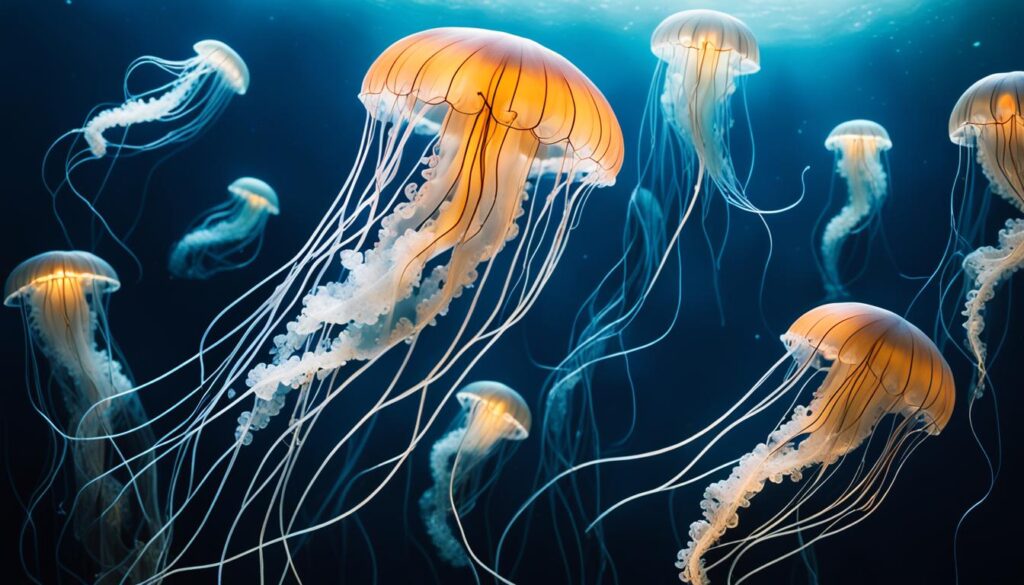
Types of Jellyfish
Jellyfish belong to the phylum Cnidaria, which also includes other fascinating creatures like sea anemones and corals. Within this phylum, there are various types of jellyfish, each with its distinct characteristics. Here are a few notable examples:
| Jellyfish | Description |
|---|---|
| Moon Jellyfish | Ambient stingers, these translucent jellyfish have a distinct saucer-shaped bell and short tentacles. They are commonly found in coastal waters. |
| Box Jellyfish | Recognized by their boxy shape and long, venomous tentacles, these jellyfish are known to be among the most venomous creatures on Earth. They inhabit the warm waters of the Pacific and Indian Oceans. |
| Lion’s Mane Jellyfish | Boasting the title of the world’s largest jellyfish, the lion’s mane jellyfish has a distinctive mane-like appearance with long, colorful tentacles. These giants can be found in the northern regions of the Atlantic and Pacific Oceans. |
| Comb Jellyfish | Unlike traditional jellyfish, comb jellyfish belong to a different group called Ctenophora. With their unique comb-like rows of cilia, these gelatinous creatures propel themselves through the water. They inhabit both saltwater and freshwater environments. |
These are just a few examples of the rich tapestry of jellyfish species that populate our oceans. Each type has its own adaptations, survival strategies, and ecological significance.
However, it’s important to note that while jellyfish are captivating, they can also pose risks to humans. Some species have venomous tentacles that can deliver painful stings. It’s crucial to exercise caution and respect when encountering jellyfish in their natural habitats.
“Jellyfish are mysterious marine creatures that remind us of the incredible diversity and beauty of the underwater world.”
As we continue to explore the depths of our oceans, the secrets of jellyfish and their fascinating adaptations are just waiting to be discovered. These ethereal beings serve as a testament to the captivating wonders that exist beneath the waves.
Juncos
Juncos are small, sparrow-like birds that are commonly found in North America. They belong to the bird species and are known for their distinctive gray or brown plumage and a white belly. These North American birds are migratory, spending their summers in forests and their winters in open areas.
One interesting fact about juncos is their feeding behavior. They primarily feed on seeds and insects, making them valuable contributors to plant pollination and insect control in their habitats. Juncos are often seen foraging on the ground, hopping and scratching the leaf litter in search of food.
Another notable characteristic of juncos is their delightful song, which is often described as a trilling whistle. It’s a common sound heard in North American forests during the spring breeding season, as male juncos sing to attract mates and establish territories.
Key Features of Juncos:
- Small, sparrow-like birds
- Distinctive gray or brown plumage
- White belly
- Migratory birds, spending summers in forests and winters in open areas
- Feed on seeds and insects
- Known for their trilling whistle song
Juncos in North America
Juncos are widely distributed across North America, with different subspecies occupying various regions. Some common subspecies include the Dark-eyed Junco (Junco hyemalis) and the Yellow-eyed Junco (Junco phaeonotus).

| Species | Scientific Name | Range |
|---|---|---|
| Dark-eyed Junco | Junco hyemalis | Throughout North America |
| Yellow-eyed Junco | Junco phaeonotus | Southwestern United States and Mexico |
Junglefowl
Junglefowl are medium-sized birds that are native to the forests of Southeast Asia. They are known for their vibrant feathers, especially the males who have colorful plumage and long tail feathers. Junglefowl are the ancestors of domestic chickens and exhibit behaviors similar to their domesticated counterparts.
These fascinating birds feed on a varied diet that includes seeds, fruits, insects, and small animals. Their ability to adapt to different environments within the jungle allows them to find a diverse range of food sources. Junglefowl play an essential role in maintaining the balance of their ecosystems as seed dispersers and insect controllers.
| Characteristics | Behavior | Habitat |
|---|---|---|
| Junglefowl have vibrant plumage with beautiful colors. | Junglefowl exhibit mating displays and territorial behaviors. | They inhabit the dense forests and jungles of Southeast Asia. |
| The males have long tail feathers that they display during courtship. | Junglefowl roost in trees and forage on the forest floor. | They prefer areas with dense vegetation and access to water sources. |
| Their diet consists of mainly seeds, fruits, insects, and small animals. | Junglefowl communicate through various vocalizations, including loud calls. | They can be found in countries like India, Thailand, and Indonesia. |
Junglefowl are not only visually stunning but also hold great significance as the ancestors of domestic chickens. Through observing their behaviors and studying their biology, scientists gain insights into the evolutionary process that led to the domestication of chickens. Their presence in the jungle adds charm and beauty to these diverse ecosystems.
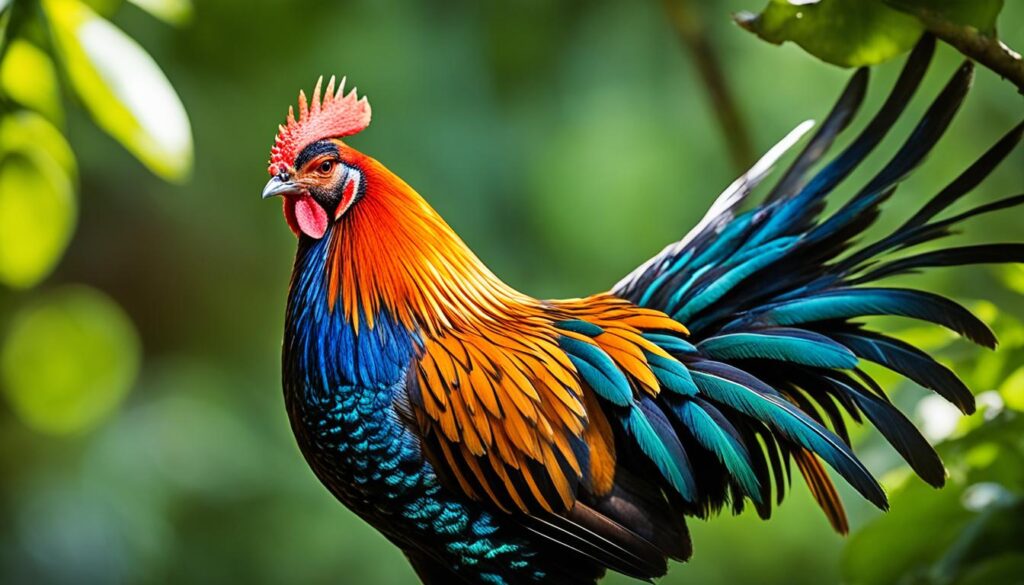
Continue exploring the fascinating world of animals that start with J by diving into the next section on Jerboas.
Jerboas
Jerboas are fascinating desert animals that belong to the family Dipodidae. These small jumping rodents are well-adapted to life in arid environments and exhibit unique physical features that enable their survival in harsh conditions.
One distinguishing characteristic of jerboas is their long hind legs, which allow them to execute impressive leaps and bounds. These remarkable jumping abilities enable them to traverse the sandy terrain of desert regions with ease, evading predators and efficiently foraging for food.
Jerboas are primarily nocturnal, meaning they are most active during the nighttime. This behavior helps them avoid the scorching heat of the desert during the day. They have keen senses, enabling them to locate seeds, insects, and various plant materials under the cover of darkness.
With their streamlined bodies and long tails, jerboas maintain balance and control during their agile movements. Their tails serve as an additional tool for stability as they navigate the challenging dunes and sandy landscapes of their habitats.
These remarkable desert rodents play an important role in their ecosystems by dispersing seeds and controlling insect populations. Their adaptations and behaviors have allowed them to thrive in some of the harshest environments on Earth, making them true survivors of the desert.
“Jerboas showcase incredible agility and acrobatic skills, making them one of the most remarkable desert animals.”
Types of Jerboas
There are several species of jerboas, each with its own unique characteristics and adaptations:
- Five-toed Jerboa (Allactaga elater): Found in Central Asia, this species has five toes on its hind feet and a long, tufted tail.
- Long-eared Jerboa (Euchoreutes naso): Recognized by its oversized ears, this jerboa inhabits the deserts of China and Mongolia.
- Fat-tailed Jerboa (Pygeretmus sp.): Known for its plump tail, this species is found in the deserts of North Africa and Central Asia.
The Remarkable Jumping Abilities of Jerboas
One of the most intriguing aspects of jerboas is their exceptional jumping capabilities. Their elongated hind legs allow them to leap several times their body length, enabling quick escapes from predators and efficient movement across their desert habitats.
While they primarily use their hind legs for propulsion, jerboas also utilize their long tails for balance and precise landings. These incredible adaptations have allowed jerboas to become masters of the desert, surviving and thriving in extremely challenging conditions.
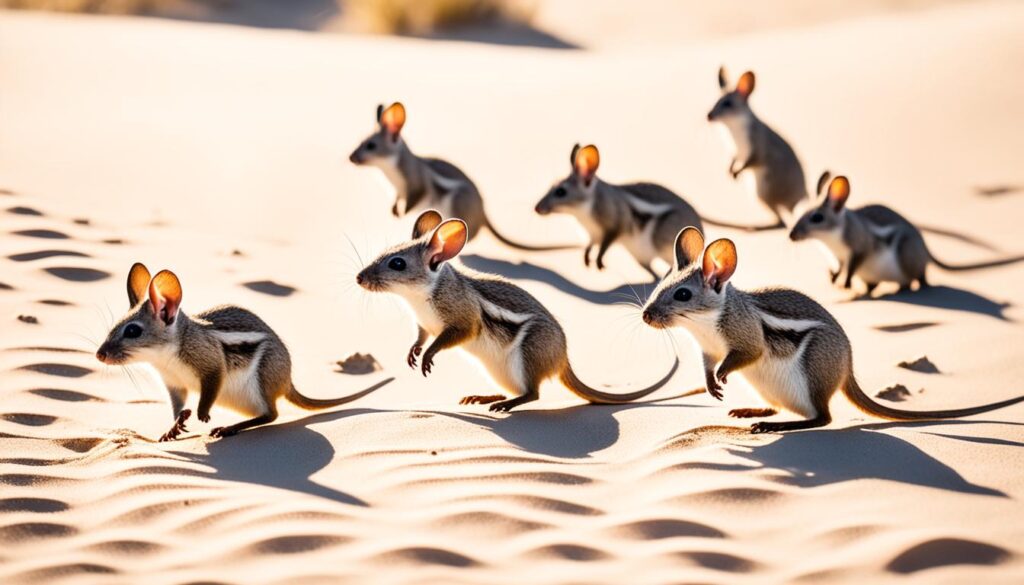
Jabiru
The jabiru is a large stork species that is native to South and Central America. With its tall body, long legs, and large bill, the jabiru has a distinctive appearance. These storks can reach heights of up to 5 feet and have a predominantly white plumage, adorned with black markings on their wings and head. They are truly magnificent creatures.
Jabirus can be found in wetland habitats, where they feed on a variety of prey including fish, reptiles, and other small animals. Their long legs and sharp bill make them skilled hunters, enabling them to thrive in their natural environment. These South American birds play an important role in the ecosystem, maintaining the balance of wetland ecosystems and contributing to the biodiversity of the region.
If you ever encounter a jabiru during your visit to South or Central America, consider yourself lucky. These storks are a sight to behold and witnessing their graceful flight and hunting prowess is a truly remarkable experience.
Let us take a closer look at some fascinating features of the jabiru in the table below:
| Feature | Description |
|---|---|
| Size | Can reach heights of up to 5 feet |
| Plumage | Predominantly white with black markings on wings and head |
| Habitat | Wetland habitats in South and Central America |
| Diet | Feeds on fish, reptiles, and small animals |
As you can see, the jabiru is truly a remarkable stork species and a testament to the beauty of South American birds. Their unique characteristics and role in the ecosystem make them a fascinating subject of study and observation.
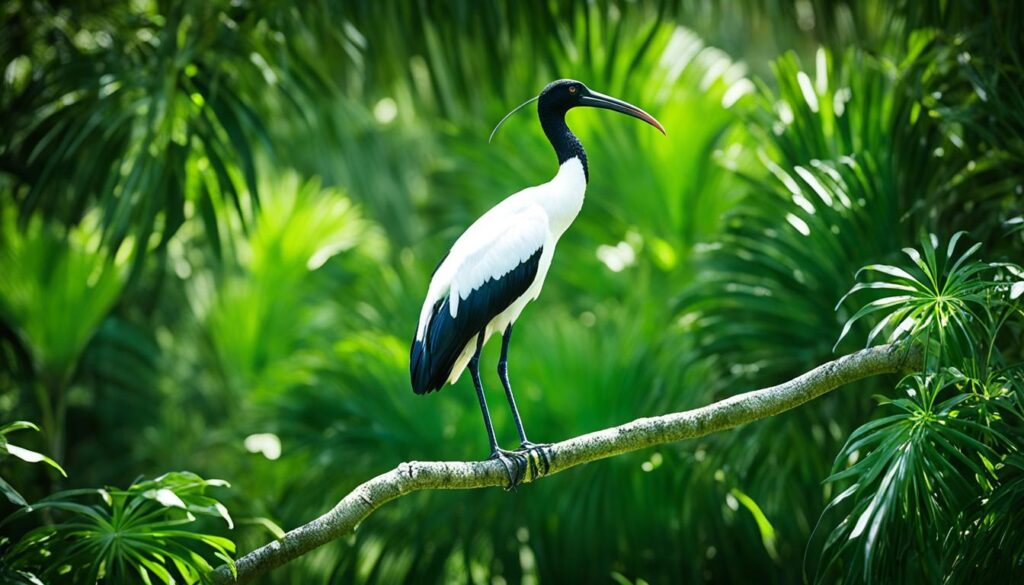
Stay tuned for the next section, where we will delve into another captivating creature beginning with the letter J.
Jacamars
Jacamars are small, colorful birds that are native to the forests of Central and South America. With their slender bodies, long bills, and vibrant plumage, jacamars are a sight to behold. These beautiful bird species captivate observers with their striking appearance and fascinating behaviors.
Jacamars are insectivores, meaning they primarily feed on insects. Their slender bills are uniquely adapted for capturing their prey with precision. These birds have a unique hunting style that involves perching on a branch and patiently waiting for their prey to come within range. Once their target is within striking distance, jacamars swiftly snatch the insect from the air with their sharp bills, demonstrating their agility and hunting prowess.
The vibrant plumage of jacamars adds to their charm. The colorful feathers adorn their bodies, making them a visual delight. Some species exhibit a combination of bright hues, including metallic blues, greens, and iridescent purples. The vibrant colors of jacamars make them highly sought after by bird enthusiasts and photographers.
Importantly, jacamars play a crucial role in the ecosystems of Central and South America. As insectivores, they help control insect populations, contributing to the delicate balance of the forest ecosystem. Their feeding habits make them valuable allies in maintaining the ecological health of their habitats.
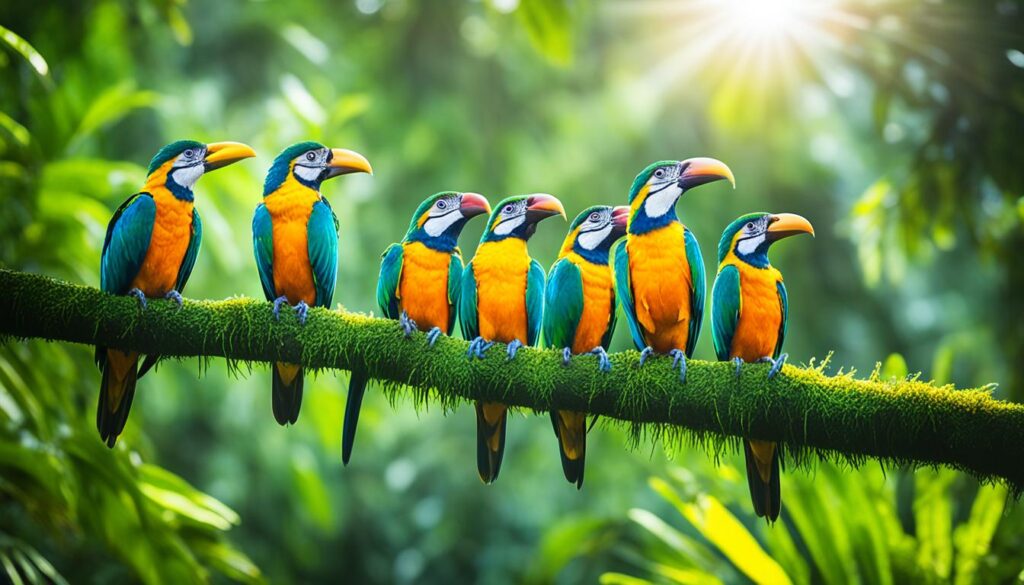
These remarkable bird species serve as a testament to the diverse and captivating wildlife found in the forests of Central and South America. Their elegance, insectivorous diet, and significant ecological contributions make jacamars a subject of fascination for bird enthusiasts and nature lovers alike.
Jellyfish
Jellyfish are fascinating marine animals that come in a variety of shapes and sizes. They are known for their gelatinous bodies and trailing tentacles. Jellyfish can be found in all oceans and have unique adaptations for survival, such as stinging cells for capturing prey. While some species of jellyfish are harmless, others can deliver painful stings to humans.
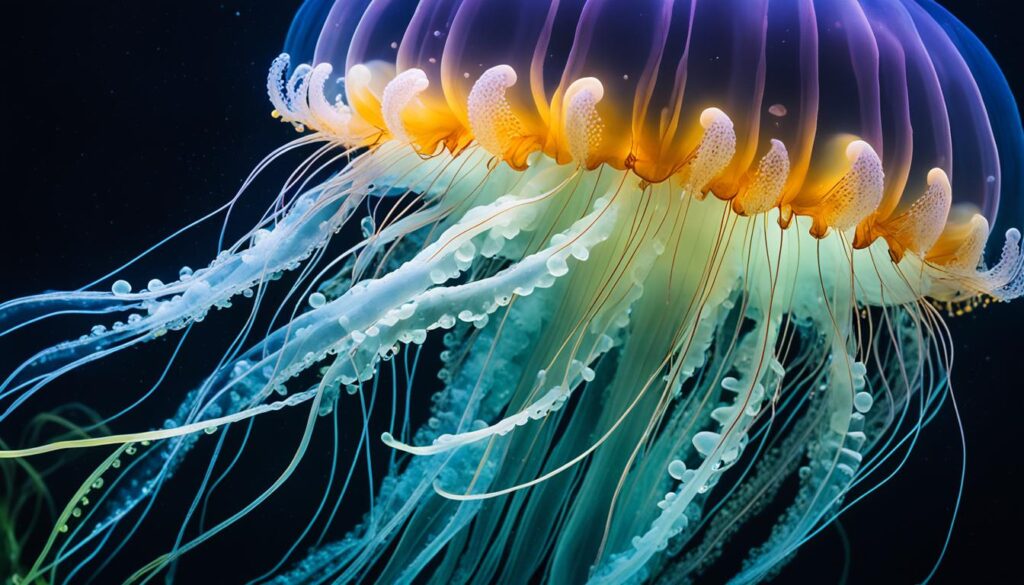
These mesmerizing creatures belong to the phylum Cnidaria, which also includes corals and sea anemones. There are thousands of known species of jellyfish, each exhibiting its own striking features and behavior.
Types of Jellyfish
Here are some notable types of jellyfish:
| Jellyfish | Scientific Name | Habitat | Size |
|---|---|---|---|
| Moon Jellyfish | Aurelia aurita | Coastal waters, estuaries | Up to 16 inches (40 cm) in diameter |
| Box Jellyfish | Chironex fleckeri | Tropical and subtropical waters | Up to 10 feet (3 m) in length |
| Portuguese Man o’ War | Physalia physalis | Open ocean | Tentacles can reach up to 165 feet (50 m) |
These are just a few examples of the diverse jellyfish species that inhabit our oceans. Each of them has its own unique characteristics and adaptations that make them remarkable marine animals.
“Jellyfish are intriguing creatures that showcase the beauty and complexity of marine life. Their transparent bodies and graceful movements captivate the imaginations of both scientists and nature enthusiasts.”
When encountering jellyfish in their natural habitat, it’s important to observe them from a safe distance and avoid any physical contact. If stung by a jellyfish, it’s crucial to seek appropriate medical attention.
Next, let’s explore another remarkable animal that starts with the letter J: the jackrabbit.
Jackrabbit
Jackrabbits are large hare species that are native to North America. Despite their name, jackrabbits are not true rabbits but belong to the hare family. They have long ears, powerful hind legs, and a distinctive running gait. Jackrabbits are well adapted to desert habitats and can run at high speeds to escape predators. They primarily feed on grasses and other plant material.
These North American mammals are known for their incredible agility and speed. Their long legs enable them to cover great distances in a single bound, making them excellent escape artists from predators. Jackrabbits are most active during the early morning and evening hours, avoiding the intense heat of the day in their arid habitats.
The jackrabbit’s remarkable ears not only contribute to its iconic appearance but also aid in thermoregulation. The large surface area helps dissipate heat, keeping the jackrabbit cool in the scorching desert temperatures. Additionally, their keen hearing serves as an early warning system for potential threats.
With their herbivorous diet, jackrabbits play an important role in the ecosystem. By grazing on grasses and other plant material, they help control vegetation growth and contribute to seed dispersal, promoting plant biodiversity. They are also a vital food source for predators such as coyotes, foxes, and birds of prey.
Although commonly referred to as jackrabbits, these hare species have several distinct subspecies, each adapted to specific regions within North America. Some notable examples include the black-tailed jackrabbit, white-tailed jackrabbit, and antelope jackrabbit.
“The jackrabbit’s incredible speed and agility have earned it a reputation as one of the fastest land animals in North America.” – Wildlife Expert
Overall, the jackrabbit’s unique characteristics and ecological significance make it a fascinating member of the North American mammal community.
Jackrabbit Facts
- Belongs to the hare family, not true rabbits
- Native to North America
- Distinctive long ears and powerful hind legs
- Adapted to desert habitats
- Can run at high speeds to escape predators
- Herbivorous diet of grasses and plant material
- Plays an important role in controlling vegetation growth and seed dispersal
- Vital prey species for predators such as coyotes and birds of prey
| Scientific Classification | |
|---|---|
| Kingdom | Animalia |
| Phylum | Chordata |
| Class | Mammalia |
| Order | Lagomorpha |
| Family | Leporidae |
| Genus | Lepus |
| Species | Various, including Lepus californicus, Lepus townsendii, Lepus alleni |
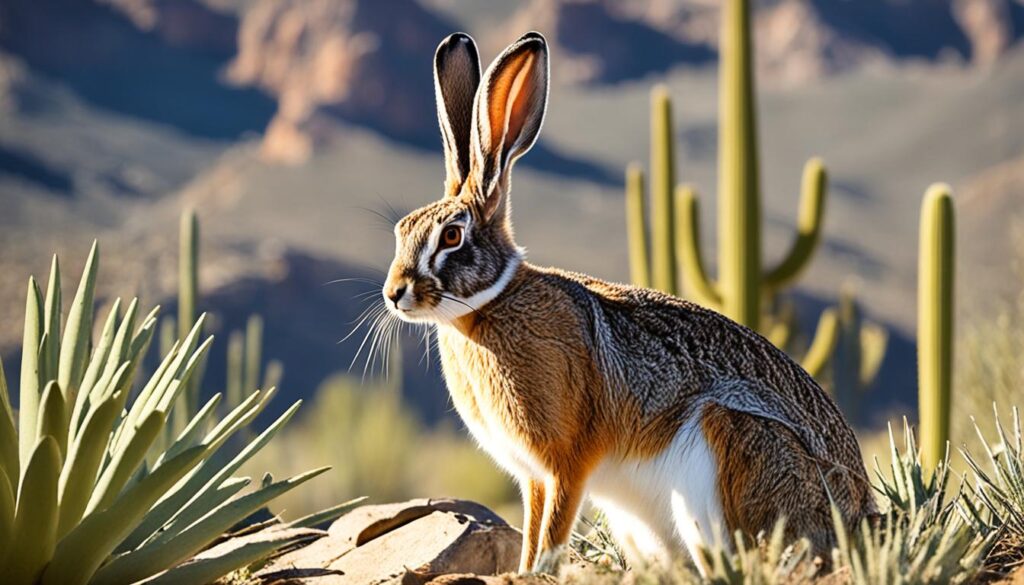
Jaegers
Jaegers are large seabirds known for their aggressive behavior and kleptoparasitic feeding habits. These birds belong to the genus Stercorarius and are primarily found in the Arctic region. There are three species of jaegers: the long-tailed jaeger, the Arctic jaeger, and the pomarine jaeger.
The long-tailed jaeger, also known as the long-tailed skua, is the smallest species of jaegers. It has a distinctive long, pointed tail and can be found nesting in the Arctic tundra. During the breeding season, its plumage changes to a beautiful mix of gray, brown, and white. The long-tailed jaeger feeds on fish, insects, and small seabirds.
The Arctic jaeger, also called the parasitic jaeger, is the most widespread species of jaegers. It has a dark brown plumage and a powerful flight. The Arctic jaeger is known for its aggressive nature, often chasing other seabirds to steal their food. It primarily feeds on fish, but also scavenges on the eggs and chicks of other seabirds.
The pomarine jaeger is the largest species of jaegers and has a distinctive breeding plumage with a prominent, elongated central tail feather. It breeds in the Arctic regions and migrates to the Southern Hemisphere during the winter. The pomarine jaeger primarily feeds on fish, but it also opportunistically steals food from other seabirds.

Jaegers play an important role in the Arctic ecosystem, both as predators and scavengers. They help control populations of fish and small seabirds, contributing to the balance of the marine food web. These seabirds are fascinating to observe, with their aerial acrobatics and skillful hunting techniques.
Conclusion
In summary, the world of animals that start with J is vibrant and diverse, encompassing a wide range of species across different taxonomic groups. From the cunning jackals and majestic jaguars to the colorful jays and graceful jabirus, each animal brings its own unique characteristics and adaptations that make them fascinating to study and observe.
These animals can be found in various habitats, from the dense jungles to the arid deserts, and they play crucial roles in maintaining the balance of their respective ecosystems. Whether as predators, scavengers, or seed dispersers, animals that start with J contribute to the intricate web of life and the overall health of our natural world.
Understanding and appreciating the diversity of these animals is not only essential for conservation efforts but also for enriching our knowledge of the natural world. By protecting their habitats and ensuring their survival, we can continue to witness the wonders of these incredible creatures for generations to come.
